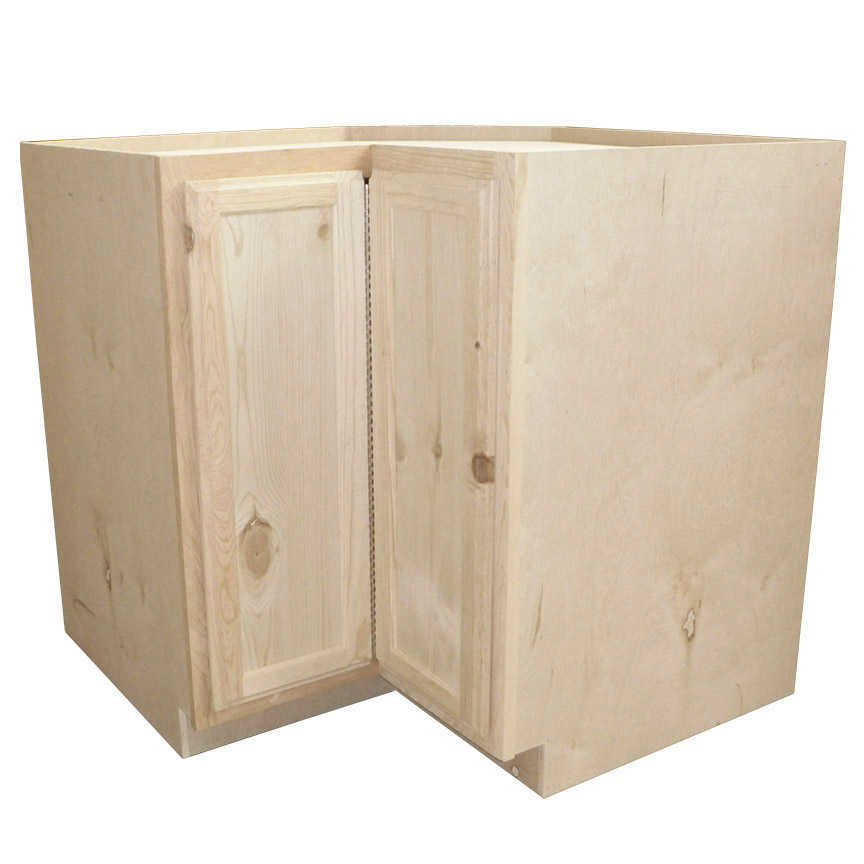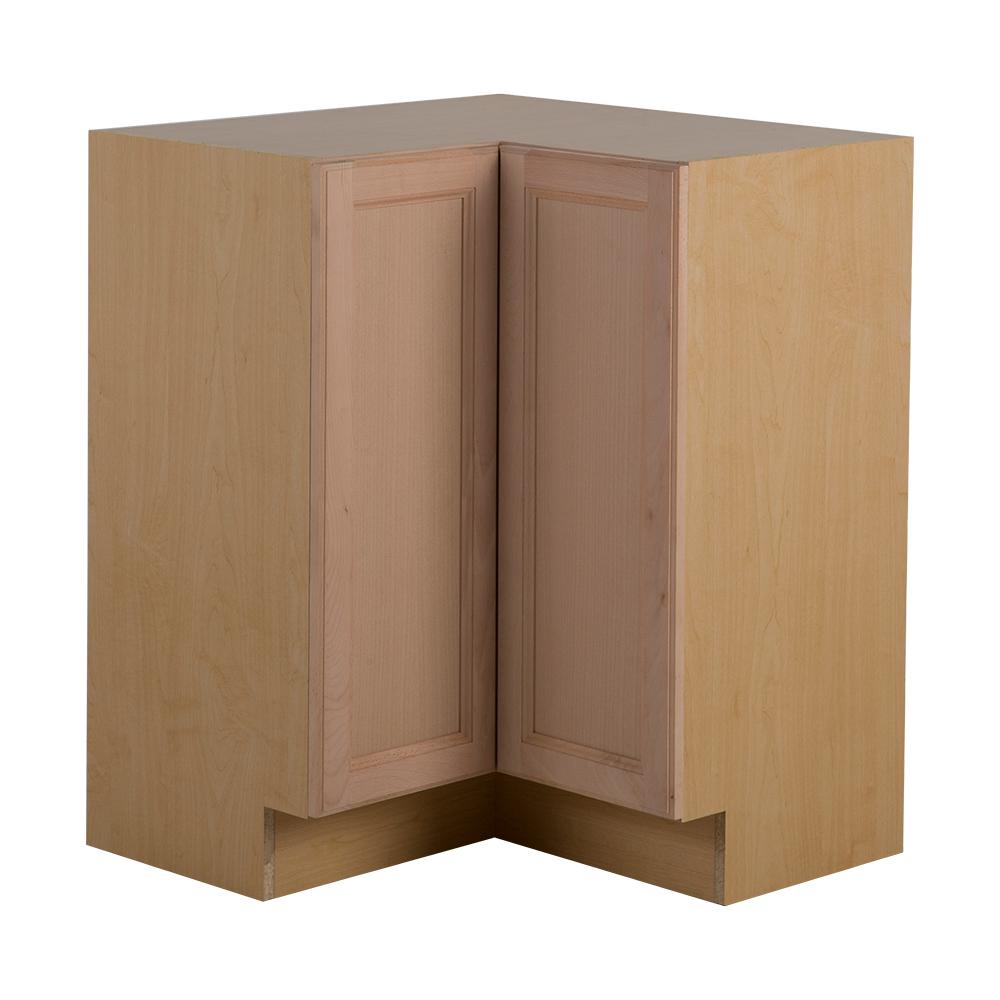Understanding Unfinished Corner Kitchen Cabinets

Unfinished corner kitchen cabinets offer a unique opportunity to personalize your kitchen design. These cabinets arrive in a raw state, allowing you to customize them with your preferred paint, stain, or finish. This approach provides a blank canvas for your creative vision, enabling you to perfectly match your cabinets to your kitchen’s overall aesthetic.
Benefits of Unfinished Corner Kitchen Cabinets
Unfinished corner kitchen cabinets offer a range of advantages:
- Customization: Unfinished cabinets allow you to choose the exact color, stain, or finish that best complements your kitchen’s design. This ensures a cohesive and personalized look.
- Cost Savings: In some cases, unfinished cabinets can be more affordable than pre-finished options, as you eliminate the cost of factory-applied finishes.
- Unique Design: Unfinished cabinets provide the freedom to create unique designs and patterns. You can experiment with different finishes, distressing techniques, or even add decorative elements.
Drawbacks of Unfinished Corner Kitchen Cabinets
While unfinished cabinets offer numerous advantages, there are also some drawbacks to consider:
- Additional Work: Unfinished cabinets require additional time and effort for finishing. You’ll need to sand, prime, and apply your chosen finish, which can be a time-consuming process.
- Potential for Mistakes: Finishing cabinets yourself can lead to mistakes if you lack experience. Uneven application or improper sanding can affect the final appearance.
- Limited Availability: Unfinished corner kitchen cabinets might not be readily available from all manufacturers, limiting your options.
Types of Unfinished Corner Kitchen Cabinets
Unfinished corner kitchen cabinets are available in various styles and configurations:
- Lazy Susan Cabinets: These cabinets feature a rotating platform, providing easy access to stored items. Unfinished lazy susan cabinets allow you to customize the finish to match your kitchen’s design.
- Blind Corner Cabinets: These cabinets utilize a space-saving design that utilizes the corner space effectively. Unfinished blind corner cabinets can be customized to fit your specific needs and aesthetic.
- Base Cabinets: Unfinished base cabinets offer a foundation for your kitchen’s design. They can be customized with different finishes, hardware, and countertop options.
Materials Used in Unfinished Corner Kitchen Cabinets
Unfinished corner kitchen cabinets are typically constructed from various materials:
- Wood: Wood is a popular choice for unfinished cabinets, offering durability, beauty, and the ability to accept a variety of finishes. Common wood types include maple, cherry, oak, and birch.
- MDF (Medium-Density Fiberboard): MDF is a cost-effective alternative to wood. It provides a smooth surface for finishing and is often used for cabinet doors and drawer fronts.
- Plywood: Plywood offers strength and stability, making it suitable for cabinet construction. It is often used for cabinet boxes and shelves.
Installation and Customization: Unfinished Corner Kitchen Cabinet

The installation of unfinished corner kitchen cabinets presents a unique set of challenges and rewards. The lack of pre-finished surfaces allows for greater flexibility in customization and integration with existing cabinetry, but it also requires careful planning and execution to ensure a seamless and durable outcome.
Steps Involved in Installing Unfinished Corner Kitchen Cabinets
Installing unfinished corner kitchen cabinets involves a series of steps, each requiring precision and attention to detail.
- Preparation: Begin by carefully measuring the space where the cabinets will be installed, ensuring the area is clean and free of obstructions. This step is crucial for achieving a precise fit.
- Framing: For most installations, a sturdy framework is required to support the cabinets. This may involve constructing a wall, adding supports, or reinforcing existing structures. The framing should be level and plumb to ensure the cabinets are installed correctly.
- Cabinet Placement: Once the framing is complete, carefully position the cabinets within the space, ensuring they are aligned and level. This step often involves using shims and leveling tools to achieve the desired fit.
- Securing the Cabinets: Use screws, nails, or other appropriate fasteners to secure the cabinets to the framing. The number and type of fasteners will vary depending on the weight and size of the cabinets.
- Finishing: After the cabinets are installed, the unfinished surfaces can be painted, stained, or sealed to achieve the desired look. This step allows for a high degree of customization and integration with existing cabinetry.
Customizing Unfinished Cabinets to Fit Specific Kitchen Layouts
Unfinished cabinets offer a unique opportunity to create a kitchen that perfectly reflects your individual style and needs.
- Unique Shapes and Sizes: Unfinished cabinets can be easily customized to fit odd-shaped spaces or to create unique layouts. For example, a corner cabinet can be modified to accommodate a specific appliance or to create a custom storage solution.
- Integration with Existing Cabinetry: Unfinished cabinets can be easily matched to existing cabinetry, creating a cohesive and unified look. This is especially important when adding new cabinets to an existing kitchen.
- Specialized Features: Unfinished cabinets can be customized with features like built-in spice racks, pull-out drawers, or custom shelving to meet your specific storage needs.
Integrating Unfinished Cabinets with Existing Cabinetry
The key to integrating unfinished cabinets with existing cabinetry lies in achieving a seamless and cohesive look.
- Matching Finishes: If the existing cabinets are painted, stain the new cabinets to match the existing color. If the existing cabinets are stained, paint the new cabinets to match the existing color. This will create a unified look throughout the kitchen.
- Using Matching Hardware: Use the same hardware on both the new and existing cabinets to further enhance the unified look. This includes door pulls, knobs, and hinges.
- Blending Styles: If the existing cabinets have a different style than the new cabinets, consider using a transitional style that blends the two. For example, if the existing cabinets are traditional, the new cabinets could be a more contemporary style that complements the existing design.
Potential Challenges and Solutions During Installation
Installing unfinished corner kitchen cabinets can present a few challenges, but with careful planning and execution, these can be easily overcome.
- Difficult Access: Installing cabinets in a corner can be challenging due to limited access. Consider using specialized tools or techniques to reach tight spaces.
- Uneven Surfaces: Uneven walls or floors can make it difficult to install cabinets correctly. Use shims and leveling tools to ensure the cabinets are installed level and plumb.
- Matching Existing Cabinetry: Matching the finish and style of existing cabinetry can be challenging. Consider using a professional painter or stain specialist to achieve a perfect match.
Finishing and Styling

The raw canvas of unfinished corner kitchen cabinets presents an exciting opportunity to personalize your space, reflecting your unique style and taste. The finishing process transforms these cabinets from mere structures into statement pieces that elevate the entire kitchen’s aesthetic.
Finishing Techniques
A variety of techniques can be employed to achieve different looks and finishes for unfinished corner cabinets.
- Painting: A classic and versatile option, painting allows for a wide range of colors and finishes, from bold and vibrant hues to subtle and sophisticated shades.
- Staining: This technique enhances the natural grain and color of the wood, adding depth and character to the cabinets. Staining can range from light and subtle to rich and dramatic.
- Varnishing: Varnish provides a protective layer that enhances the natural beauty of the wood while offering resistance to scratches, stains, and moisture.
- Glazing: Glaze creates a translucent layer that adds depth and dimension to the cabinet finish, highlighting details and creating a subtle, aged effect.
- Distressing: This technique involves intentionally creating imperfections, such as scratches, chips, and dents, to give the cabinets a rustic and antique look.
Creating Unique and Personalized Finishes
Beyond the basic finishing techniques, numerous ways exist to create unique and personalized cabinet finishes.
- Color Combinations: Experiment with contrasting colors for a bold statement or complementary shades for a harmonious look.
- Textured Finishes: Incorporate textured paints, metallic finishes, or even fabric for a unique and tactile experience.
- Stencils and Decals: Add intricate patterns or decorative elements to the cabinet doors using stencils or decals.
- Hardware: Choose unique and stylish hardware, such as knobs, pulls, and hinges, to complement the overall cabinet finish.
Color Palettes and Styles
The chosen color palette and style should complement the unfinished cabinets and the overall kitchen aesthetic.
- Traditional Kitchen: Warm, earthy tones like cream, beige, and brown, combined with classic hardware, create a timeless and elegant look.
- Modern Kitchen: Sleek and minimalist, modern kitchens often feature clean lines, neutral colors like white, gray, and black, and bold accents.
- Rustic Kitchen: Natural wood finishes, distressed paint, and reclaimed materials create a cozy and inviting atmosphere.
- Contemporary Kitchen: Bold colors, geometric patterns, and unique hardware create a modern and sophisticated look.
Impact of Finishes on Kitchen Aesthetic
The chosen finish significantly impacts the overall kitchen aesthetic, influencing the mood, style, and functionality of the space.
- Light and airy: Light colors, such as white or cream, create a sense of spaciousness and openness, making the kitchen feel larger and brighter.
- Warm and inviting: Rich, earthy tones, like brown or red, add warmth and comfort to the kitchen, making it feel more inviting and cozy.
- Modern and sleek: Bold colors and geometric patterns create a modern and sophisticated look, while minimalist hardware emphasizes clean lines and functionality.
- Rustic and charming: Distressed finishes, natural wood tones, and reclaimed materials create a rustic and charming atmosphere, adding character and warmth to the kitchen.
The unfinished corner kitchen cabinet, a testament to a project left half-done, stands as a constant reminder of potential. Its empty shelves, however, can be transformed into a haven of organization with the help of kitchen cabinet shelf holders.
These simple yet effective additions can create a sense of order within the cabinet, maximizing its storage capacity and finally realizing its potential as a functional and aesthetically pleasing element of the kitchen.
The unfinished corner kitchen cabinet, a testament to the ongoing project, sits patiently, a canvas for the homeowner’s vision. Perhaps a sleek, modern aesthetic, or a rustic, farmhouse charm, the possibilities are endless. A trip to 84 Lumber for inspiration might just be the catalyst for unlocking the potential of this blank slate.
With a little planning and the right materials, this unfinished corner cabinet will soon become a focal point of the kitchen, a testament to the homeowner’s creativity and resourcefulness.
